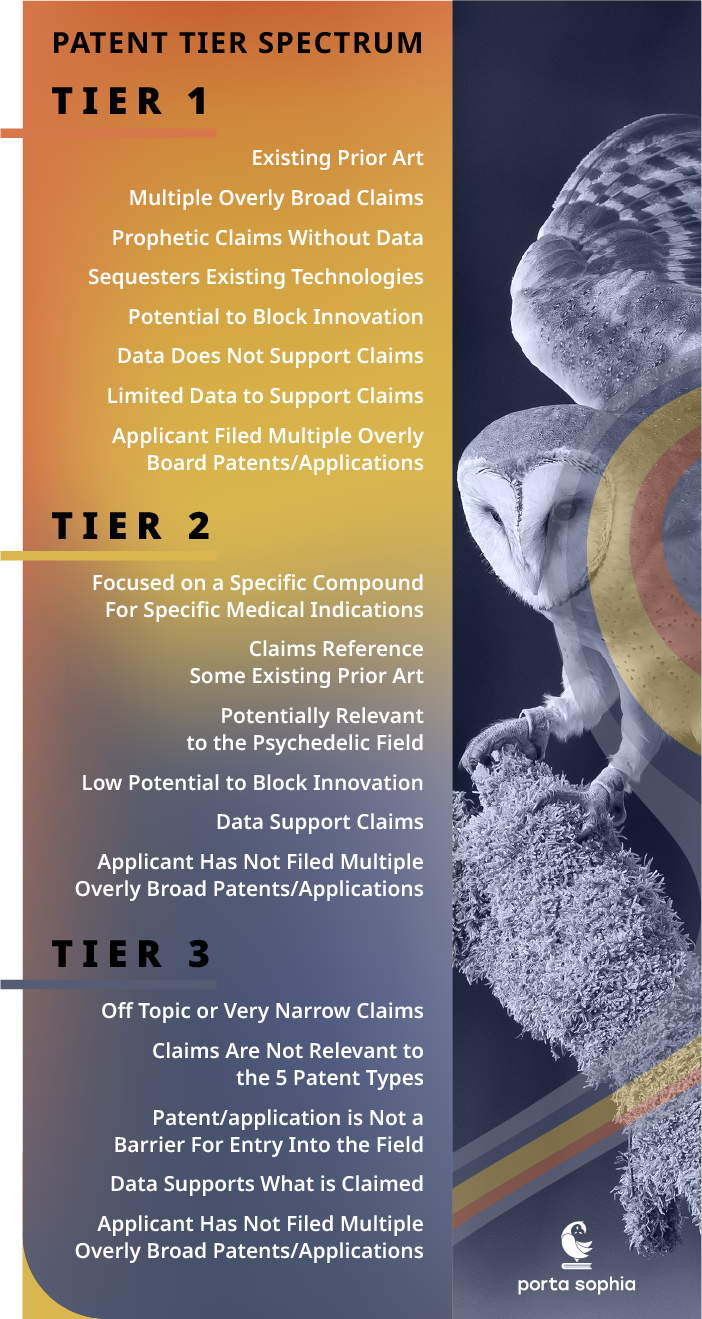Our Three Tier Decision Process for Evaluating Patents/Applications and Filing Third-Party Preissuance Submissions/Observations
As part of our mission to protect the public domain, stimulate innovation and support good patents, we review all U.S. and international patents/applications referencing any of the 33 psychedelic compounds tracked on our shortlist. Below, we define the three-tier system used to evaluate and categorize patents/applications, with tier 1 posing the highest and tier 3 posing the lowest threat to the psychedelic field. Threat is defined as the potential to sequester existing technologies and knowledge in the public domain and block innovation, research, access, and entry into the field. We assess the claims, data, posed threat, and applicant to assign a tier ranking and determine if tier 1 applications are good candidates for intervention via a U.S. third-party preissuance submission or an international third-party observation.
What Is a U.S. Third-Party Preissuance Submission or International Third-Party Observation?
Definition from USPTO
35 U.S.C. 122(e) provides a mechanism for third parties to submit patents, published patent applications, or other printed publications of potential relevance to the examination of a patent application with a concise description of the asserted relevance of each document submitted.
International Third-Party Observation processes are dependent upon the filing country - please visit corresponding patent office websites for more information.
What does that mean?
When a patent application is filed it is typically published in the USPTO database 18 months after the earliest filing date. On average, it takes two years for an application to reach final disposition when it is either approved or rejected by the patent examiner assigned to the case. During this time, any third-party can provide prior art to challenge one or more of the claims made in the patent application by filing a third-party preissuance submission. During this process, the third party will provide prior art challenging the patentability of the application’s claim(s). This may force the applicant to amend or cancel their claims and will ensure that the patent examiner has the relevant prior art available during their review process.
What Is Our Three Tier System, and How Do We Assign a Tier to a Patent or Application?
First Step – U.S. and International Patent/Application Search
We begin by reviewing all U.S. and international patents/applications referencing any of the 33 compounds on our short list on a weekly basis. Our team searches for keywords in the title, abstract, claims and description of the published patents/applications.
Second Step – Evaluate Claims, Threat, and Data
During our weekly patent search, our team evaluates newly published patents/applications to assess the scope of claims in relation to the data presented in the filing and determine the potential threat to sequester technologies and knowledge existing in the public domain.
Third Step – Evaluate Applicant
As a secondary evaluation criterion weighted less than claims, threat and data, the team evaluates the patent portfolio of the assignee to determine if they have filed multiple overly broad patents/applications.
Fourth Step – Assign a Tier
After evaluating the patents/applications and determining the level of threat to the public domain, we categorize the patents/applications into one of three tiers, with tier 1 posing the highest threat and tier 3 posing the lowest.
Tier 1: Highest Priority
Tier 1 patents/applications contain the following criterion in claims, threat, data and applicant.
- Overly broad claims referencing existing technologies and knowledge in the public domain
- Multiple overly broad claims
- Prophetic claims (reasonably expected future or anticipated results) without data
- Potential to sequester existing technologies in the public domain
- Potential to block research, innovation and entry into the field
- No relevant data to support what is claimed
- Limited data that does not fully support what is claimed
- Applicant has filed multiple overly broad patents/applications
Tier 2: Moderate Priority
Tier 2 patents/applications contain the following criterion in claims, threat, data and applicant.
- Claims focus on a specific compound for specific medical indications
- Some claims reference some existing knowledge and technology in the public domain
- Potentially relevant to the psychedelic field
- Low potential to block research, innovation and entry into the field
- Data presented in patent/application supports the scope of what is claimed
- Applicant has not filed multiple overly broad patents/applications
Tier 3: Low Priority
Tier 3 patents/applications contain the following criterion in claims, threat, data and applicant.
- Off topic or very narrow claims
- Claims are not relevant to the 5 Patent Types
- Patent/application is not a barrier for entry into the field
- Data supports what is claimed
- Applicant has not filed multiple overly broad patents/applications
